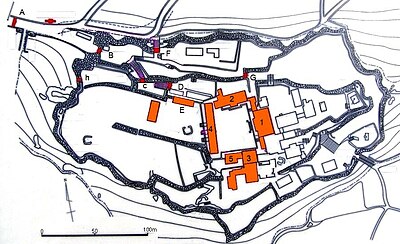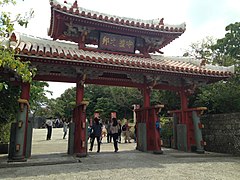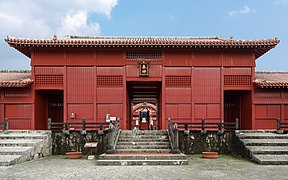Shuri Castle
| Shuri Castle | ||
|---|---|---|
|
Shuri, main palace |
||
| Creation time : | 14th Century | |
| Castle type : | Hirayamajiro ( hill castle ) | |
| Conservation status: | Largely destroyed by fire | |
| Place: | Naha | |
| Geographical location | 26 ° 13 '1.3 " N , 127 ° 43' 10.1" E | |
|
|
||
The Shuri Castle ( Japanese 首 里 城 , Shuri-jō , Okinawa : Sui Gushiku ) is located in the Shuri district of the city of Naha on the island of Okinawa , Okinawa Prefecture . In the Edo period , the Shō, rulers of the Kingdom of Ryūkyū , today's Okinawa, resided there .
After extensive destruction in the Second World War , the castle was extensively reconstructed until 1992. On October 31, 2019, a major fire completely destroyed the most important UNESCO World Heritage buildings .
history
Shuri Castle is located on the southern edge of the hill of the same name. The highest built-up part is called Kyō-no-uchi ( 京 の 内 ). It is said that at the time of the “Three States” ( 三 山 , Sanzan ), King Satsuto ( 察 度 ) of Chūzan built a tall pavilion called “Takayozauri” ( 高 ヨ ザ ウ リ ) at the end of the 14th century .
After the union of the three realms under Shō Hashi ( 尚 巴 志 ; 1371-1439) a wall was built around the Kyō-no-uchi. The three gates Zuisen-mon ( 瑞 泉 門 ), Bifuku-mon ( 美 福 門 ) and Shūjun-mon ( 淑 順 門 ) were created. In 1428 the gate Chūzan-mon ( 中山 門 ) was added, which had a plaque with his name.
At the end of the 15th century to the beginning of the 16th century Shō Shin ( 尚 真 王 ; ruled 1477–1526) built the wall on the north side, expanded the castle and laid the three gates Kankai-mon ( 歓 会 門 ), Kyūkei-mon ( 久 慶 門 ) and Uteki-mon ( 右 掖 問 ). In addition, the magnificent main palace ( 正殿 , silk) was built.
At the time of the Ming embassies, the North Palace ( 北 殿 , Hokuden ), the Enkaku-ji Temple ( 円 覚 寺 ), the Enkanji Pond ( 円 監 池 ), the Tama'udon ( 玉 陵 ), the Sunehiyan'utaki ( 園比 屋 武 御 嶽 ) and other built and used.
Around 1546, King Shō Sei ( 尚 清 ; ruled 1527–1555) expanded the complex to the east and south, the gates Keisei-mon ( 継 世 門 ), Taiken-mon ( 待 賢 門 ), also Shuri-mon ( 首 里門 ) called. In 1664 the plaque with the inscription "Land of Decency" ( 守禮 之 邦 , Shurei no kuni ) was permanently attached to the Taiken-mon - which gave it its current name Shurei-mon .
When the northern islands came under the rule of Shimazu from Satsuma in 1627 , King Shō Hō ( 肖 豊 ; ruled 1621-1640) received their delegation in the south palace ( 南 殿 , Minamids ) built for this purpose . In 1660 the main palace and the north and south palaces burned down. However, the buildings were rebuilt and covered with tiles. In 1709 the buildings burned down again and were rebuilt with the help of the Shimazu. In 1846 extensive repairs were made.
In 1879 the Japanese government ordered the ruling King Shō Tai ( 肖泰 ; 1848–1879) to abandon the castle.
On May 12, 1945, the castle with the palaces was destroyed in the attacks by the Americans during the Battle of Okinawa . In 1958 the Shurei Gate was rebuilt, and in 1972 the complex was declared a National Heritage Site ( 国 史跡 , Kuni-shiato ). In 1992 the main palace was restored, other buildings followed. In 2000, UNESCO declared the remaining remains of the castle complex from the time before the reconstruction as part of the "Archaeological Sites (Gusuku) of the Kingdom of the Ryukyu Islands" a World Heritage Site .
On October 31, 2019, a fire broke out in the main palace in Seiden , which spread to other parts of the complex. During the major fire, a total of 6 buildings with an area of 4,200 m² were completely destroyed.
The plant before the fire disaster on October 31, 2019
Inside, the castle was divided into different areas and protected by walls. Furthermore, the entire complex was enclosed by a continuous long wall ring.
Before the fire on October 31, 2019, the most important buildings of the palace complex stood at the highest point; they enclosed a large courtyard. On the east side were the main hall [1] in the north the north palace [2], in the south the smaller south palace [3], next to it the guard ( 番 所 , bansho ) [5]. This courtyard was entered through three gates in an elongated gateway [4], the "gate to worship" ( 奉 神 門 , Hōshin-mon ).
You entered the castle down in the east through the Shurei Gate ( 守礼 門 ) [A]. The path continued through the gates through the wall sections, namely through the Kankai gate [B], the Zuisen gate [C], the Rokoku gate ( 漏刻 門 ) [D] and finally [E], the Kōfuku gate ( 広 福 門 ). There is also the Kyūkei Gate [F], the Utetsu Gate [G] in the north and the Kibiki Gate ( 木 曳 門 ) H in the west.
The whole complex had long been a public park.
photos
The Shurei Gate
Shuri Castle in 2012
See also
literature
- Natascha Albus among others: The UNESCO World Heritage. Monuments of humanity - wonders of nature. Kunth, Munich 2015, ISBN 978-3-95504-207-3 , p. 465.
- Oleg Benesch, Ran Zwigenberg: Japan's Castles. Citadels of Modernity in War and Peace. Cambridge University Press, Cambridge 2019, ISBN 978-1-10848-194-6 , p. 374 (English).
- Koichi Ikeda: Shuri-jo. In: Masayuki Miura (ed.): Shiro to jinya. Saikoku-hen. Gakken, 2006, ISBN 978-4-05-604379-2 (Japanese).
- Tze May Loo: Heritage politics: Shuri Castle and Okinawa's incorporation into modern Japan 1879-2000. Lexington Books, Lanham 2014, ISBN 978-0-7391-8249-9 (English).
- Yasuhiro Nishigaya (Ed.): Shuri-jo. In: Nihon meijo zukan, Rikogaku-sha. 1993, ISBN 4-8445-3017-8 (Japanese).
Web links
- Official site of Shuri Castle (English)
- Shurijo Castle Park - The royal castle of the Ryukyu Kingdom . In: Visit-Okinawa.com
- Sören Kittel: Shuri, a burned symbol . In: Welt.de , October 31, 2019
Notes and individual references
- ↑ 首 里 城 . In: 首 里 ・ 那覇 方言 音 声 デ ー タ ベ ー ス . Ryūkyū University, accessed July 5, 2016 (Japanese).
- ↑ World Heritage Site Destroyed - Historic Shuri Castle in Japan burned down. In: Spiegel.de. October 31, 2019, accessed October 31, 2019 .
- ^ World Heritage List: Gusuku Sites and Related Properties of the Kingdom of Ryukyu. In: UNESCO.org. Retrieved October 31, 2019 .
- ↑ Sören Kittel: Shuri, a burned symbol. In: Welt.de. October 31, 2019, accessed October 31, 2019 .
- ↑ Fire destroys Okinawa's Shuri Castle. In: 3.NHK.or.jp. October 31, 2019, accessed November 1, 2019 .
- ↑ The inscription 中山 世 土 can be read as "Chūzan (ie the king of Ryūkyū) rules over this area".









